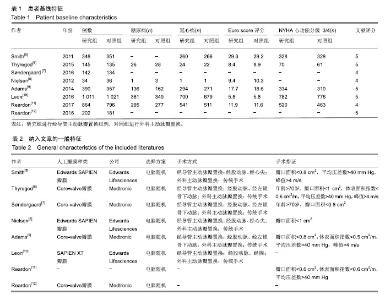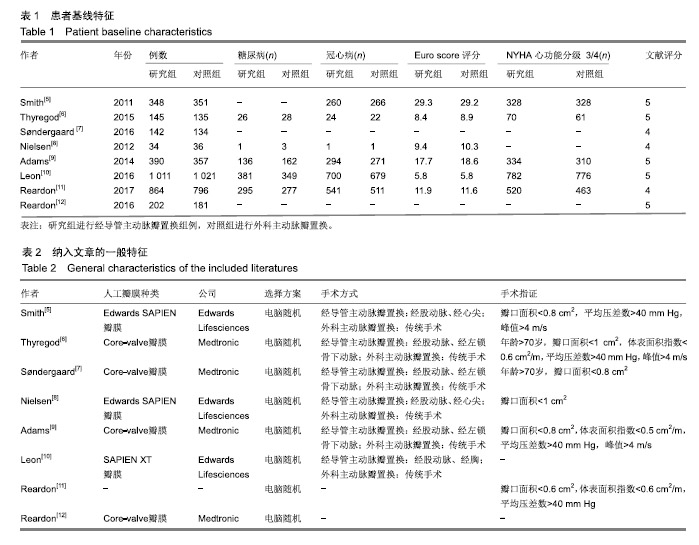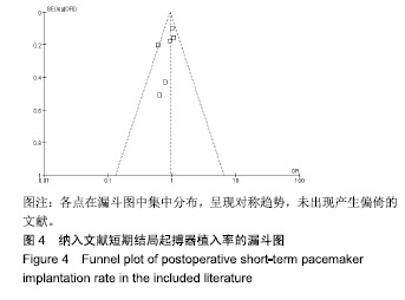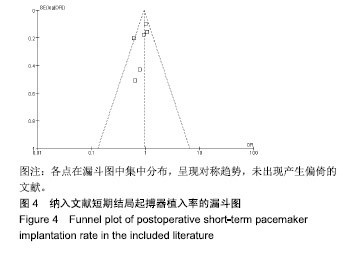Chinese Journal of Tissue Engineering Research ›› 2019, Vol. 23 ›› Issue (30): 4905-4912.doi: 10.3969/j.issn.2095-4344.1411
Previous Articles Next Articles
Efficacy of transcatheter aortic vavle repalcement and surgical aortic vavle replacement for aortic stenosis: a Meta analysis
- 1Second Department of Internal Medicine, 2Third Department of Internal Medicine, Sanya Traditional Chinese Medical Hospital, Sanya 572000, Hainan Province, China; 3Department of Cardiology, Peking University People’s Hospital, Beijing 100044, China
-
Received:2018-05-21Online:2019-10-28Published:2019-10-28 -
About author:Yin Peiyong, Attending physician, Second Department of Internal Medicine, Sanya Traditional Chinese Medical Hospital, Sanya 572000, Hainan Province, China -
Supported by:the National Natural Science Foundation of China, No. 81600340 (to LSF)
CLC Number:
Cite this article
Yin Peiyong, Cui Xiaohong, Xiong Ting, Li Sufang, He Ximin. Efficacy of transcatheter aortic vavle repalcement and surgical aortic vavle replacement for aortic stenosis: a Meta analysis[J]. Chinese Journal of Tissue Engineering Research, 2019, 23(30): 4905-4912.
share this article
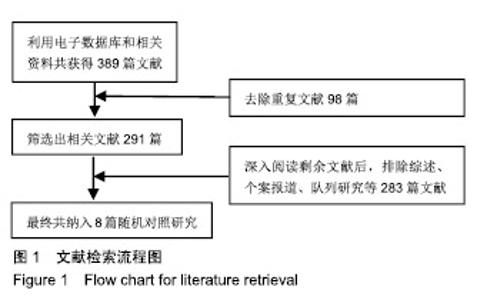
2.1 文献检索结果和质量评价 利用数据库和相关资料共检索到389篇文章,仔细审阅摘要和全文后去除重复文献98篇;深入阅读剩余文献后,排除综述、个案报道、Meta分析、队列研究等283篇文献,最终共纳入8篇随机对照研 究[5-12],见图1。8篇随机对照研究共纳入6 147例患者,研究组(n=3 136)进行经导管主动脉瓣置换组例,对照组 (n=3 011)进行外科主动脉瓣置换。纳入文献中使用的人工瓣膜主要分为Core-valve瓣膜和Edwards SAPIEN瓣膜,两种瓣膜均为生物瓣膜,生物兼容性好,临床疗效佳。所有文献纳入的患者均为电脑随机分组,大部分文章中两组患者选择指征为瓣口面积<1 cm2且伴有临床症状。经导管主动脉瓣置换入路主要分为经股动脉、经左锁骨下动脉、经胸和经心尖4种入路,但是文章中没有具体说明4种入路的患者例数及预后。但是所有文章中,两组所提及的患者选择、患者基本资料、手术指征选择等基线资料比较差异无显著性意义(P > 0.05),见表1,2,两组之间具有可比性。"
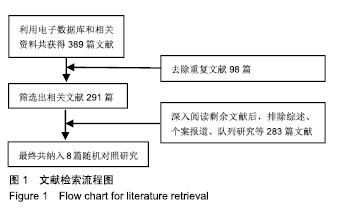
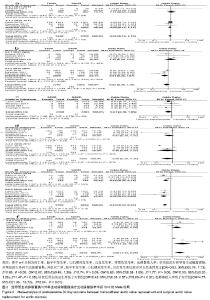
2.2 结果分析 2.2.1 术后30 d短期结局 主要结局:①5篇文章报道了经导管主动脉瓣置换和外科主动脉瓣置换治疗主动脉瓣狭窄的死亡率[5-6,8,10-11],各研究间无异质性(卡方检验值Chi2=2.27,自由度df=4,P=0.69,I2=0%),因此应用固定效应模型。Meta分析结果显示两组死亡率无明显差异[OR=0.92,95%CI(0.74,1.13),Z=0.83,P=0.40],见图2a;②6篇文章报道了经导管主动脉瓣置换和外科主动脉瓣置换治疗脑卒中的发生 率[5-6,8-9,10-11],各研究间异质性有明显差异(卡方检验值Chi2=13.94,自由度df=5,P=0.02,I2=64%),因此采用随机效应模型。Meta分析结果显示两组术后脑卒中发生率无明显差异[OR=0.82,95%CI(0.49,1.38),Z=0.74,P=0.46],见图2b。亚组分析的结果也未见明显差异。 次要结局:①4篇文章报道了经导管主动脉瓣置换和外科主动脉瓣置换术后心肌梗死发生率[5-6,10-11],各研究间异质性未见明显差异(卡方检验值Chi2=1.4,自由度df=3,P=0.70,I2=0%),因此采用固定效应模型。Meta分析结果显示两组术后心肌梗死发生率无明显差异[OR=0.63,95%CI(0.38,1.05),Z=1.77,P=0.08],见图2c;②6篇文章报道了经导管主动脉瓣置换和外科主动脉瓣置换术后出血发生率[5-6,8-11],各研究间异质性可见明显差异(卡方检验值Chi2=157.43,自由度df=5,P < 0.001,I2=97%),因此采用随机效应模型。Meta分析结果显示两组术后心肌梗死发生率无明显差异[OR=0.50,95%CI(0.20,1.26),Z=1.47,P=0.14],见图2d;③6篇文章报道了经导管主动脉瓣置换和外科主动脉瓣置换术后肾损伤发生率[5-6,8-11],各研究间异质性未见明显差异(卡方检验值Chi2=7.23,自由度df=5,P=0.20,I2=31%),因此采用固定效应模型。Meta分析结果显示研究组术后肾损伤发生率明显低于对照组[OR=0.43,95%CI(0.33,0.57),Z=5.89,P < 0.001],见图2e;④6篇文章报道了经导管主动脉瓣置换和外科主动脉瓣置换术后起搏器植入率[5-6,8-11],各研究间异质性可见明显差异(卡方检验值Chi2=49.39,自由度df=2,P < 0.01,I2=90%),因此采用随机效应模型。Meta分析结果显示研究组起搏器植入率明显高于对照组[OR=3.08,95%CI(1.46,6.50),Z=2.44,P < 0.001],见图2f。"
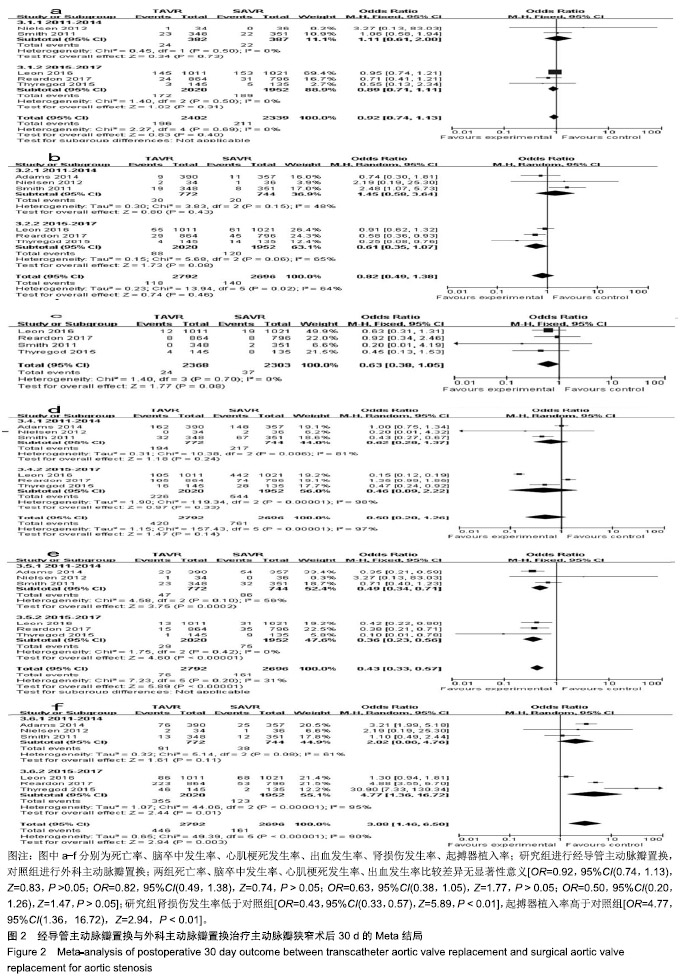
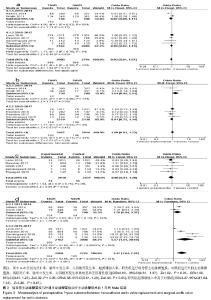
2.2.2 术后1年长期结局 主要结局:①6篇文章报道了经导管主动脉瓣置换和外科主动脉瓣置换治疗主动脉瓣狭窄的死亡率[5-7,9-11],各研究间无异质性(卡方检验值Chi2=6.47,自由度df=5,P=0.26,I2=23%),因此应用固定效应模型。Meta分析结果显示两组死亡率无明显差异[OR=0.93,95%CI(0.81,1.07),Z=1.02,P=0.31],见图3a;②6篇文章报道了经导管主动脉瓣置换和外科主动脉瓣置换治疗主动脉瓣狭窄的脑卒中发生 率[5,7,9-12],各研究间可见显著异质性(卡方检验值Chi2=8.92,自由度df=5,P=0.11,I2=44%),因此应用随机效应模型。Meta分析结果显示两组死亡率无明显差异[OR=1.00,95%CI(0.81,1.23),Z=0.02,P=0.99],见图3b。 次要结局:①5篇文章报道了经导管主动脉瓣置换和外科主动脉瓣置换治疗主动脉瓣狭窄的术后心梗发生 率[5-7,10-11],各研究间可见显著异质性(卡方检验值Chi2=1.94,自由度df=4,P=0.75,I2=0%),因此应用随机效应模型。Meta分析结果显示两组术后心肌梗死发生率无明显差异[OR=0.88,95%CI(0.61,1.28),Z=0.65,P=0.52],见图3c;②7篇文章报道了经导管主动脉瓣置换和外科主动脉瓣置换治疗主动脉瓣狭窄的术后起搏器植入率[5-7,9-10,12],各研究间可见显著异质性(卡方检验值Chi2=53.55,自由度df=5,P < 0.001,I2=91%),因此应用随机效应模型。Meta分析结果显示两组术后起搏器植入率无明显差异[OR=3.47,95%CI(1.64,7.34),Z=3.26,P=0.001],见图3d。亚组分析中,2015至2017年纳入的文献提示:研究组起搏器植入率明显高于对照组(P < 0.05)。 "
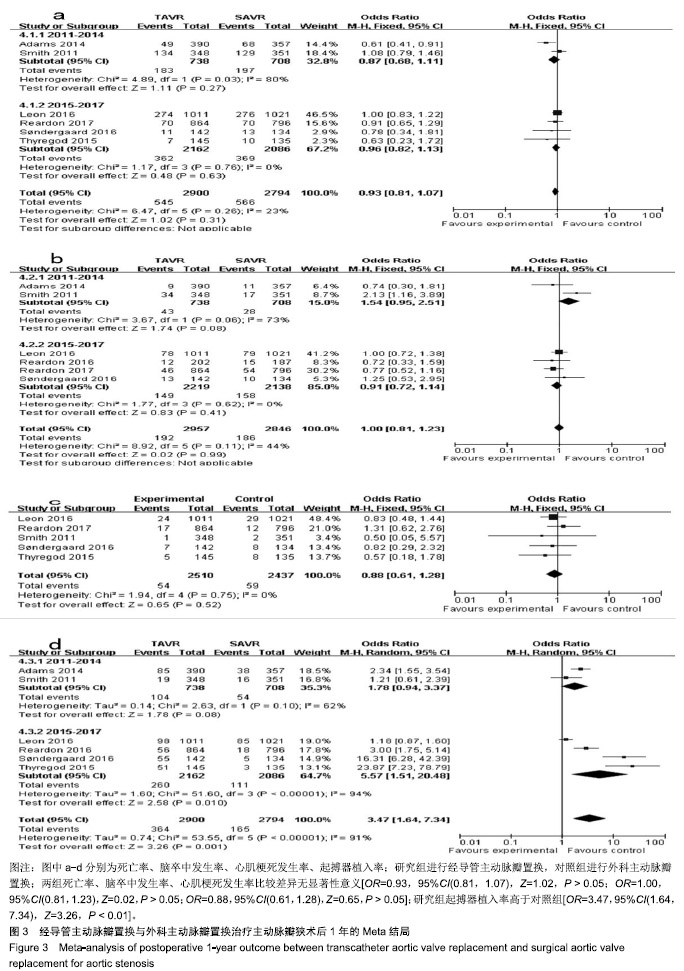
| [1]Strike E,Arklina B,Stradins P,et al.Postoperative pain management strategies and delirium after transapical aortic valve replacement: a randomized controlled trial.J Cardiothorac Vasc Anesth. 2018;1-5.[2]Liu Z,Kidney E,Bem D,et al.Transcatheter aortic valve implantation for aortic stenosis in high surgical risk patients: A systematic review and meta-analysis.PLoS One. 2018;13(5):e0196877.[3]Wang Y,Zhou Y,Zhang L,et al.Midterm outcome of transcatheter versus surgical aortic valve replacement in low to intermediate risk patients: a meta-analysis of randomized controlled trials. J Cardiol. 2018;71(6):534-539.[4]Svenssin LG,Blackstone EH,Rajeswaran J,et al.Comprehensive analysis of mortality among patients undergoing TAVR results of the PARTNER Trial.J Am Coll Cardiol.2014;64(2):158-168.[5]Smith CR,Leon MB,Mack MJ,et al.Transcatheter versus surgical aortic-valve replacement in high-risk patient.N Engl J Med. 2011; 364(23):2187-2198.[6]Thyregod HG,Steinbruchel DA,Ihlemann N,et al.Transcatheter versus surgical aortic valve replacement in patients with severe aortic valve stenosis 1-year results from the all-comers notion randomized clinical trial J Am Coll Cardiol.2015;57(5):276-280.[7]Søndergaard L,Steinbrüchel DA,Ihlemann N,et al.Two-year outcomes in patients with severe aortic valve stenosis randomized to transcatheter versus surgical aortic valve replacement the all-comers nordic aortic valve intervention randomized clinical trial.Circ Cardiovasc Interv.2016;9(6):e003665.[8]Nielsen HH,Klaaborg KE,Nissen H,et al.A prospective, randomised trial of transapical transcatheter aortic valve implantation vs. surgical aortic valve replacement in operable elderly patients with aortic stenosis: the STACCATO trial. EuroIntervention. 2012;8(3): 383-389.[9]Adams DH,Popma JJ,Reardon MJ,et al.Transcatheter Aortic-Valve Replacement with a Self-Expanding Prosthesis.N Engl J Med. 2014; 371(10):967-968.[10]Leon ML,Smith CR,Mack MJ,et al.Transcatheter or surgical aortic-valve replacement in intermediate-risk patients.N Engl J Med. 2016;374(17):1609-1620.[11]Reardon MJ,Van NM,Popma J,et al.Transcatheter or surgical aortic-valve replacement in intermediate-risk patients.N Engl J Med. 2017;376(14):1321-1331.[12]Reardon MJ,Kleiman NS,Adams DH,et al.Outcomes in the randomized corevalve US pivotal high-risk trial in patients with a society of thoracic surgeons risk score of 7% or less.JAMA Cardiol. 2016;1(8):945-949.[13]Gargiulo G,Sannino A,Capodanno D,et al.Transcatheter aortic valve implantation versus surgical aortic valve replacement a systematic review and meta-analysis.Ann Intern Med. 2016;165(5):334-344.[14]Siemieniuk RA,Agoritsas T,Manja V,et al.Transcatheter versus surgical aortic valve replacement in patients with severe aortic stenosis at low and intermediate risk: systematic review and meta-analysis.BMJ.2016;354:i5130.[15]郭丽娜,施仲伟.经导管Edwards-Sapien主动脉瓣植入术临床应用[J].国际心血管病杂志, 2011,38(4):209-212.[16]李昕,刘世栋,朱鹏冲,等.经导管主动脉瓣置入术的研究进展[J].国际心血管病杂志,2018,45(1):8-11.[17]Arora S, Misenheimer JA,Ramaraj R.Transcatheter aortic valve replacement: comprehensive review and present status.Tex Heart Inst J.2017;44(1):29-38.[18]Fischer-Rasokat U,Renker M,Liebetrau C,et al. 1-yearsurvival after TAVR of patients with low-flow, low-gradient and high-gradient aortic valve stenosis in matched study populations.JACC Cardiovasc Interv. 2019;12(8):752-763.[19]Elmaraezy A,Ismail A,Abushouk AI.Efficacy and safety of transcatheter aortic valve replacement in aortic stenosis patients at low to moderate surgical risk: a comprehensive meta-analysis.BMC Cardiovasc Disord.2017;17(1):234.[20]Mack MJ,Leon MB,Thourani VH,et al.Transcatheter aortic-valve replacement with a balloon-expandable valve in low-risk patients.N Engl J Med.2019;380(18):1695-1705.[21]Guedeney P,Tchétché D,Petronio AS,et al.Impact of coronary artery disease and percutaneous coronary intervention in women undergoing transcatheter aortic valve replacement: From the WIN-TAVI registry.Catheter Cardiovasc Interv. 2019;93(6): 1124-1131.[22]Solomonica A,Choudhury T,Bagur R.Newer-generation of Edwards transcatheter aortic valve systems: SAPIEN 3, Centera, and SAPIEN 3 Ultra.Expert Rev Med Devices.2019;16(2):81-87.[23]Goodall G,Lamotte M,Ramos M,et al.Cost-effectiveness analysis of the SAPIEN 3 TAVI valve compared with surgery in intermediate-risk patients.J Med Econ.2019;22(4):289-296.[24]Baron SJ,Wang K,House JA,et al.Cost-effectiveness of transcatheter versus surgical aortic valve replacement in patients with severe aortic stenosis at intermediate risk. Circulation. 2019; 139(7):877-888.[25]Kapadia SR,Huded CP,Kodali SK,et al.Stroke after surgical versus transfemoral transcatheter aortic valve replacement in the PARTNER Trial.J Am Coll Cardiol. 2018;72(20):2415-2426.[26]Chen S,Redfors B,Ben-Yehuda O,et al.Transcatheter versus surgical aortic valve replacement in patients with prior cardiac surgery in the Randomized PARTNER 2A Trial.JACC Cardiovasc Interv. 2018;11(21):2207-2216.[27]Abdelghani M,Allali A,Kaur J,et al.Impact of prosthesis-iteration evolution and sizing practice on the incidence of prosthesis-patient mismatch after transcatheter aortic valve replacement.Catheter Cardiovasc Interv. 2019;93(5):971-979.[28]Still S,Szerlip M,Mack M.TAVR Vs. SAVR in intermediate-risk patients: what influences our choice of therapy.Curr Cardiol Rep. 2018;20(10):82.[29]Stähli BE,Reinthaler M,Leistner DM,et al.Transcatheter aortic vavle replacement and concomitant mitral regulation.Front Cardiovasc Med.2018;5:74.[30]Indolfi C,Bartorelli AL,Berti S,et al.Updated clinical indications for transcatheter aortic valve implantation in patients with severe aortic stenosis: expert opinion of the Italian Society of Cardiology and GISE.J Cardiovasc Med (Hagerstown).2018,19(5):197-210. |
| [1] | Chen Junming, Yue Chen, He Peilin, Zhang Juntao, Sun Moyuan, Liu Youwen. Hip arthroplasty versus proximal femoral nail antirotation for intertrochanteric fractures in older adults: a meta-analysis [J]. Chinese Journal of Tissue Engineering Research, 2021, 25(9): 1452-1457. |
| [2] | Chen Jinping, Li Kui, Chen Qian, Guo Haoran, Zhang Yingbo, Wei Peng. Meta-analysis of the efficacy and safety of tranexamic acid in open spinal surgery [J]. Chinese Journal of Tissue Engineering Research, 2021, 25(9): 1458-1464. |
| [3] | Hu Kai, Qiao Xiaohong, Zhang Yonghong, Wang Dong, Qin Sihe. Treatment of displaced intra-articular calcaneal fractures with cannulated screws and plates: a meta-analysis of 15 randomized controlled trials [J]. Chinese Journal of Tissue Engineering Research, 2021, 25(9): 1465-1470. |
| [4] | Huang Dengcheng, Wang Zhike, Cao Xuewei. Comparison of the short-term efficacy of extracorporeal shock wave therapy for middle-aged and elderly knee osteoarthritis: a meta-analysis [J]. Chinese Journal of Tissue Engineering Research, 2021, 25(9): 1471-1476. |
| [5] | Wang Yongsheng, Wu Yang, Li Yanchun. Effect of acute high-intensity exercise on appetite hormones in adults: a meta-analysis [J]. Chinese Journal of Tissue Engineering Research, 2021, 25(8): 1305-1312. |
| [6] | Kong Desheng, He Jingjing, Feng Baofeng, Guo Ruiyun, Asiamah Ernest Amponsah, Lü Fei, Zhang Shuhan, Zhang Xiaolin, Ma Jun, Cui Huixian. Efficacy of mesenchymal stem cells in the spinal cord injury of large animal models: a meta-analysis [J]. Chinese Journal of Tissue Engineering Research, 2021, 25(7): 1142-1148. |
| [7] | Huang Dengcheng, Wang Zhike, Cao Xuewei. Intravenous, topical tranexamic acid alone or their combination in total knee arthroplasty: a meta-analysis of randomized controlled trials [J]. Chinese Journal of Tissue Engineering Research, 2021, 25(6): 948-956. |
| [8] | Li Yan, Wang Pei, Deng Donghuan, Yan Wei, Li Lei, Jiang Hongjiang. Electroacupuncture for pain control after total knee arthroplasty: a meta-analysis [J]. Chinese Journal of Tissue Engineering Research, 2021, 25(6): 957-963. |
| [9] | He Xiangzhong, Chen Haiyun, Liu Jun, Lü Yang, Pan Jianke, Yang Wenbin, He Jingwen, Huang Junhan. Platelet-rich plasma combined with microfracture versus microfracture in the treatment of knee cartilage lesions: a meta-analysis [J]. Chinese Journal of Tissue Engineering Research, 2021, 25(6): 964-969. |
| [10] | Hua Haotian, Zhao Wenyu, Zhang Lei, Bai Wenbo, Wang Xinwei. Meta-analysis of clinical efficacy and safety of antibiotic artificial bone in the treatment of chronic osteomyelitis [J]. Chinese Journal of Tissue Engineering Research, 2021, 25(6): 970-976. |
| [11] | Zhan Fangbiao, Cheng Jun, Zou Xinsen, Long Jie, Xie Lizhong, Deng Qianrong. Intraoperative intravenous application of tranexamic acid reduces perioperative bleeding in multilevel posterior spinal surgery: a meta-analysis [J]. Chinese Journal of Tissue Engineering Research, 2021, 25(6): 977-984. |
| [12] | Zhong Yuanming, Wan Tong, Zhong Xifeng, Wu Zhuotan, He Bingkun, Wu Sixian. Meta-analysis of the efficacy and safety of percutaneous curved vertebroplasty and unilateral pedicle approach percutaneous vertebroplasty in the treatment of osteoporotic vertebral compression fracture [J]. Chinese Journal of Tissue Engineering Research, 2021, 25(3): 456-462. |
| [13] | Li Yang, Zhang Mingyong. Meta-analysis of the effect of double Endobutton and clavicular hook plate on the treatment of acromioclavicular dislocation [J]. Chinese Journal of Tissue Engineering Research, 2021, 25(3): 463-470. |
| [14] | Li Yanle, Yue Xiaohua, Wang Pei, Nie Weizhi, Zhang Junwei, Tan Yonghai, Jiang Hongjiang. Intramedullary nail fixation versus plate fixation in the treatment of displaced midshaft clavicular fractures in adults: a meta-analysis [J]. Chinese Journal of Tissue Engineering Research, 2021, 25(3): 471-476. |
| [15] | Liu Chang, Han Shufeng. Interlocking intramedullary nail for proximal femur versus proximal femoral anti-rotation intramedullary nail or proximal femoral anti-rotation intramedullary nail of Asian for intertrochanteric fractures in older adults: a meta-analysis [J]. Chinese Journal of Tissue Engineering Research, 2021, 25(3): 477-485. |
| Viewed | ||||||
|
Full text |
|
|||||
|
Abstract |
|
|||||
